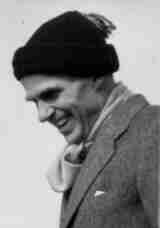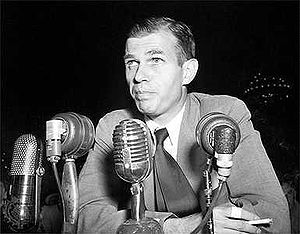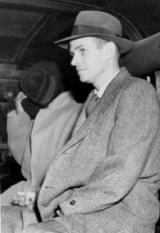 SKC Films Library SKC Films Library |
| SKC Films Library >> American History >> United States: General History and Description >> Early 20th Century, 1901-1960 >> Political History |
 Alger Hiss Alger Hissformer State Department employee who was accused of being a Communist and spy Alger Hiss was born in Baltimore, Maryland, on November 11, 1904. A very good student as a youth, he received a scholarship to Johns Hopkins University, and graduated from that institution in 1926. He subsequently received a scholarship to Harvard Law School, from which he graduated in 1929. At Harvard, he developed an intellectual and political friendship with Professor Felix Frankfurter, who got him a clerkship with Supreme Court Justice Oliver Wendell Holmes, Jr. In 1930, Hiss took a job with the Boston law firm of Choate, Hall and Stewart. In 1932, he moved to New York City, where he joined the law firm of Cotton, Franklin, Wright and Gordon. Government Career In March of 1933, at the urging of Frankfurter, Hiss accepted a position in the Legal Division of the Agricultural Adjustment Agency (AAA). In July of 1934, the AAA loaned Hiss to the the Nye Committee of the U.S. Senate, which was investigating profiteering in the munitions industry. At this time, New Deal legislation was under constant attack from conservatives, and Hiss became a point man whose specialty was defending the constitutionality of the new reforms. When the Nye Committee's work was done, Hiss joined the Justice Department as Special Assistant to the Solicitor General to help defend the AAA before the Supreme Court. In September of 1936 he was appointed to the staff of the Assistant Secretary of State for Economic Affairs, where he served until becoming assistant to the State Department's Political Adviser in Charge of Far Eastern Affairs, in 1939. During World War II, Hiss devoted much of his time and talents to the formation of a permanent postwar collective security organization. In 1943 he was a low-level participant at the Dumbarton Oaks Conference, which ultimately led to formation of the United Nations. In 1945, while serving as a member of the American delegation to the Yalta Conference, Hiss was named Director of the State Department Office of Special Political Affairs. Later that same year he served as Secretary-General of the San Francisco Conference that formally organized the United Nations. After that conference, Hiss had the honor of personally escorting the new U.N. Charter back to Washington aboard a special plane for President Harry Truman's signature. Hiss left government service in 1946 to become president of the Carnegie Endowment for International Peace, in which capacity he served until 1949. Accusations of Spying and Subsequent Trials
Hiss testifying before HUAC On August 16, Hiss was again called before HUAC. As Nixon grilled him for details about his life, Hiss came to realize that he had indeed once known Chambers, but that Chambers was at the time using a different name. On August 25, both men appeared before a public hearing that was in reality little more than a staged event for television cameras. On August 27, Chambers repeated his charges on Meet the Press. Hiss responded by filing a libel suit against Chambers. Meanwhile, both HUAC and the Justice Department were busy investigating the charges leveled by Chambers. Although the Justice Department ultimately determined that there was absolutely no basis for any charges in the case, HUAC refused to drop the matter. On November 17, 1948, during pre-trial hearings involving the libel suit, Chambers produced copies of two sets of documents, dated in 1938, he claimed had been given to him by Hiss -- typewritten facsimiles of original State Department documents, and handwritten summaries of others. Despite all his earlier claims to the contrary, Chambers now admitted that Hiss had actually engaged in espionage. Those documents, along with 58 microfilm frames of other State Department documents were ultimately handed over to both the Justice Department and HUAC. On December 15, 1948, a federal grand jury indicted Hiss on two counts of perjury -- one for his denial of having met Chambers after 1937, the other for his denial of having ever given classified State Department documents to Chambers.
Hiss in handcuffs Post-Trial Years While in prison, Hiss worked in a storeroom, played handball, taught several inmates to read, and was known as a model prisoner. He also continued to petition for a new trial. He was released for good conduct on November 27, 1954, after serving 44 months of his 5-year sentence. Having lost his law license upon his conviction, Hiss took a job as a salesman, while continuing to press his case for a new trial. In 1957, he published In the Court of Public Opinion, in which he offered new evidence of his innocence. Over the subsequent decades, Hiss made numerous attempts to have his convictions overturned, but always met with failure. He did, however, succeed in having his license to practice law in Massachusetts restored by order of the Massachusetts Supreme Court, in 1975. Hiss published his memoirs, Recollections of a Life, in 1988. He maintained his innocence to his last days, and died in New York City on November 15, 1996. OFFICIAL WEBSITE SEE ALSO |
| SKC Films Library
>> American History
>> United
States: General History and Description >> Early 20th Century, 1901-1960 >> Political History This page was last updated on June 11, 2017. |
 On
August 3, 1948, Whittaker Chambers, a confessed former
Communist and senior editor of Time magazine,
testified before the House Un-American Activities
Committee (HUAC) that Alger Hiss had been a member of a
Washington, D.C.-based Communist cell in the mid-1930's,
and that Hiss's "job" had been to promote
Communism within the federal bureaucracy. On August 5,
Hiss himself appeared before HUAC and categorically
denied ever being a Communist, as well as having ever met
Chambers. The Committee subsequently appointed a
Sub-Committee to re-interview Chambers, who subsequently
provided Sub-Committee Chairman
On
August 3, 1948, Whittaker Chambers, a confessed former
Communist and senior editor of Time magazine,
testified before the House Un-American Activities
Committee (HUAC) that Alger Hiss had been a member of a
Washington, D.C.-based Communist cell in the mid-1930's,
and that Hiss's "job" had been to promote
Communism within the federal bureaucracy. On August 5,
Hiss himself appeared before HUAC and categorically
denied ever being a Communist, as well as having ever met
Chambers. The Committee subsequently appointed a
Sub-Committee to re-interview Chambers, who subsequently
provided Sub-Committee Chairman  Hiss's perjury trial began in New York City on
May 31, 1949, and ended with a hung jury on July 7. A
second trial, also held in New York City, began on
November 17, 1949. This time prosecutors shifted their
focus to the documents presented by Chambers, rather than
on the relationship between the two men. The new strategy
worked, and Hiss was convicted on both counts on January
21, 1950. Hiss was subsequently sentenced to five years
in prison, but was released on bail pending appeal.
Hiss's appeal, which was based on a re-examination of the
trial evidence and on repeated misconduct by the
prosecutor, was denied on December 7, 1950. After failing
to get a rehearing on his appeal and failing to get the
Supreme Court to hear his case, Hiss entered the Federal
Penitentiary at Lewisburg, Pennsylvania, on March 22,
1951.
Hiss's perjury trial began in New York City on
May 31, 1949, and ended with a hung jury on July 7. A
second trial, also held in New York City, began on
November 17, 1949. This time prosecutors shifted their
focus to the documents presented by Chambers, rather than
on the relationship between the two men. The new strategy
worked, and Hiss was convicted on both counts on January
21, 1950. Hiss was subsequently sentenced to five years
in prison, but was released on bail pending appeal.
Hiss's appeal, which was based on a re-examination of the
trial evidence and on repeated misconduct by the
prosecutor, was denied on December 7, 1950. After failing
to get a rehearing on his appeal and failing to get the
Supreme Court to hear his case, Hiss entered the Federal
Penitentiary at Lewisburg, Pennsylvania, on March 22,
1951.